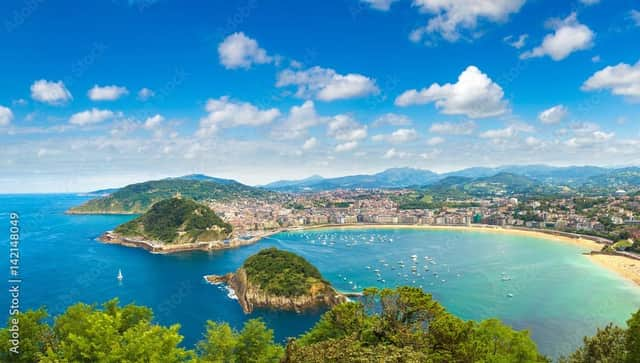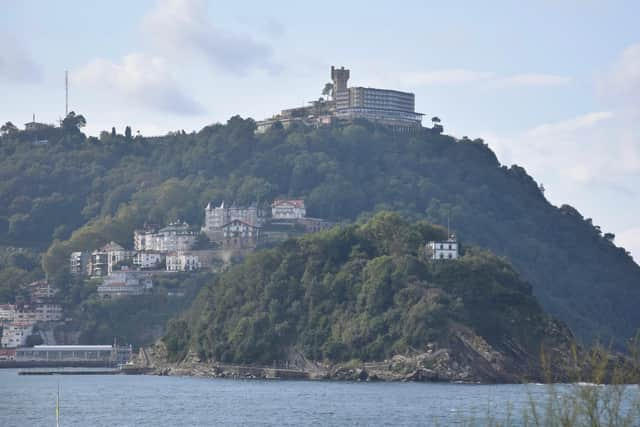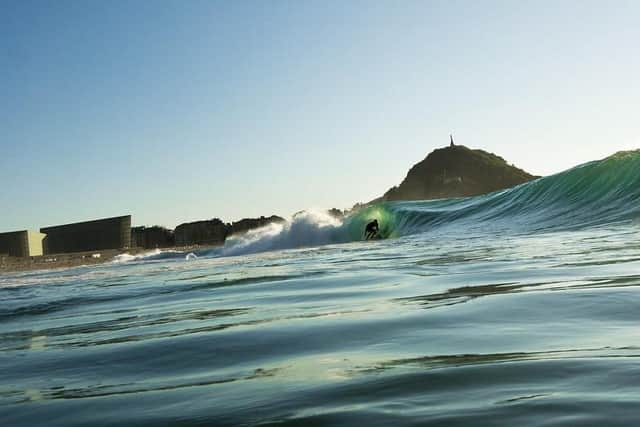San Sebastian, the waterfront city in Spain’s Basque country - Scotland on Sunday Travel


At 11pm on a Saturday night, I sit at a small table in the middle of the street as San Sebastian's night lifers wander by. Best I am alone because I'm grazing on a dish of plump octopus tentacles fried in garlic, glass of rioja to hand. This is the new part of town on the right bank of the Urumea River, home to young artists and musicians, orderly and amiably multi-cultural. Lovely girls in pelmet skirts stroll past on the impossible stilettos Spaniards love. Except that I'm not really in Spain.
San Sebastian, capital of the province of Gipuzkoa, is a wild waterfront city in the Basque heartland south of the Franco-Spanish border. The frontier spirit is anarchic, greedy for pleasure: food, drink, culture. Historically working men ran single sex cooking clubs where they competed to present their mates with exotic fish dishes. Woke has made inroads into gender specific customs, but endemic skills are reflected in Michelin stars, 19 within 25km of the centre. Three with three, Akelarre on the slopes of Mount Igueldo, the family-run Arzak and Martin Berasategui out in the countryside, two with two stars, six with one. How the Michelin inspectors must fight for this tour of duty.
Advertisement
Hide AdAdvertisement
Hide AdThe Lenten Carnival is a riot of colour and escapism. Running with the bulls on the streets of neighbouring Pamplona remains a cherished symbol of Basque manhood, a brief licence to live dangerously in an era when Health and Safety quiver when citizens cross the road. Factor in a language that predates our familiar Indo-European ones, origin disputed but unknown: there are suggestions that the Caucasus might be partly responsible. Certainly there's nothing obvious about aizto meaning knife.


With a population of 190,000, San Sebastian is an easy walk of a city, elegantly laid out on curves of the Urumea flanked extensively by parks and gardens. Near the mouth on the left bank, the old town is a grid of narrow pedestrianised streets; beyond it, the foreland is dominated by Monte Urgull, a viewing point for the golden crescent of Ondarreta and La Concha beaches, shallow, super calm, perfect for small children. More ambitious swimmers prefer Zurriola: on the right bank facing out to sea, with perfect surfing waves.
My introduction to my cultural mission came on Santa Clara islet at the foot of Urgull, reached by boat during the summer months. I was breathless from the steep trek up to the old Hondolea lighthouse, even more so gazing into the depth of Cristina Iglesias's mesmerising installation hollowed deep into its interior. The local sculptor has exposed the intricacies of the coastal rock structure, fascinating curls, shell shapes and holes burnished by sea water that surges through every couple of minutes. Reality forms and reforms as you stare into the languid swirls: they would transfix you for hours.
When delving into a city with so many novel aspects, San Telmo Museum (€6, free on Tuesdays), a repurposed 17th-century Dominican convent, is an obvious starting point. The cavernous church displays 11 monumental paintings depicting the historic Basque struggle for autonomy; ship builders, stonemasons, muscular blacksmiths forging anchors, vessels surmounting raging seas. Early 20th-century Catalan artist, Josep Sert, is wildly, richly imaginative, perhaps a spin off from his life-long friendship with Salvador Dali.
San Telmo's display moves along familiar lines: armour, musical instruments, costumes, a penny farthing, a scooter, a vintage Seat 500. There are Basque specifics, notably pelota, a game that involves hurling a ball against a wall with a hand, racket, wooden bat or narrow basket strapped to the wrist. Variously called cesta, fronton and jai alai, it has been the sport of choice here since the 1200s. Gambling and quaffing are part of the fun: check out an evening game if you can.


The temporary exhibition halls pay tribute to Eduardo Chillida, a sculptor known as San Sebastian's Gaudi. Not that his work bears any obvious resemblance to the exotic spires of Sagrada Familia, the Catalan architect's Barcelona masterpiece. Rather Chillida uses natural materials, metal, wood, pink granite, to reflect his region's industrial past. Some of his sculptures are monolithic, others figurative, and his surrealistic wrought iron pieces, reflecting their intricacies on polished surfaces, are outstanding.
In the early 1980s, Chillidas bought 27 acres of land at Hernani, a village outside San Sebastian. The grassy hill in the middle makes the perfect framework for his larger pieces. Visitors wander among the sculptures, stopping at the 16th-century farmhouse to see smaller exhibits indoors. Chillida Leku Museum opened in the 1990s, closed in 2011 nine years after the artist's death and in 2019, re-opened as a permanent memorial with financial input from the Swiss modern art gallery, Hauser & Wirth (€12, €6 on Thursdays).
After the culture, the cuisine, which in San Sebastian means pintxo– tapas in Spanish. Head east from San Telmo into the old town on Calle 31 de Agosto and look out for the hugely popular Bar Martinez 1942 opposite the spot where a parliamentarian was gunned down during the fight for an independent Basque state masterminded by the terrorist organisation, ETA, between 1959 and 2011 – memories of the troubles are never far away.
Advertisement
Hide AdAdvertisement
Hide AdWhen Manuel Martinez and Julliana Gil opened the bar in 1942, they were pintxos pioneers: Gilda was one of their first: the plate of small peppers and anchovies heads the menu 80 years later. Bonito-stuffed peppers, gleaming red with tartare sauce, and monkfish and prawn brochette are on the list of specialities.


San Sebastian's refreshing love of life extends throughout a region with easy access to the Rioja winelands. Burgos, capital of Castille until the 15th century, is a key stop on El Camino, the wannabe pilgrim's long road to Santiago de Compostela. The cash desk at the magnificent Gothic Cathedral asks if you're a caminista. Say yes and you'll get a cheaper ticket. Or head for Bilbao and Frank Gehry's Guggenheim Museum on the waterfront. From some angles, his building looks slightly like an ocean liner heading up river from the Bay of Biscay. From others, it's eerily abstract, a tangle of curves and shapes burnished with titanium against maritime corrosion. Inside, echoing galleries display towering metal installations. Brave the Basque road signs and it’s well worth the trip.
Getting there
Easyjet (easyjet.com) Manchester-Bilbao £54 return (November)
KLM (klm.co.uk) Glasgow-Bilbao via Amsterdam
Information